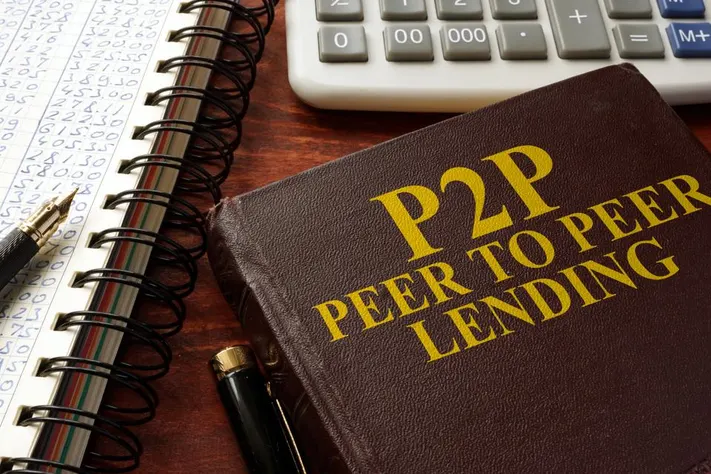Navigating the Risks and Rewards of Peer-to-Peer Lending for Accredited Investors

Key Takeaways
- Peer-to-peer lending represents a fascinating new income-generating space for accredited investors. This gives them the opportunity to lend directly to borrowers, cutting out the traditional banks and earning higher returns than traditional savings accounts. This type of investment strategy fits perfectly with investors looking for diversification and passive income streams.
- Acccredited investors can take advantage of their status to access unique opportunities available within the P2P lending world. These non-accredited peer-to-peer opportunities generally yield less than their accredited counterparts. Knowing how they define accredited investors is key to taking full advantage of these opportunities.
- Diversifying your loans is one of the most important P2P lending strategies to minimize risk. Investing in a mix of loan types, borrower grades, and P2P platforms allows investors to increase the stability of their portfolio and increase their return potential.
- Due diligence is critical before investing in individual peer loans to determine borrower creditworthiness and platform reliability. With proper research, accredited investors can make informed decisions and mitigate their default risk.
- That’s because macroeconomic factors like interest rate changes and the economic cycle play a huge role in P2P lending performance. It is critical for investors to track these moving trends to recalibrate their buying strategies and stay on the right side of a healthy portfolio allocation.
- Technological developments are key to the evolution of P2P lending, making the process more efficient and transparent. By taking advantage of these innovations, investors can improve their investing experiences and be empowered to make better data-driven investment decisions.
Peer-to-peer lending for accredited investors is a niche yield strategy. Tailored exclusively for holders of the accredited status, this niche yield strategy capitalizes on direct lending prospects that cut out the middlemen we call banks. By connecting accredited investors directly with borrowers, the platform cuts out the middleman and offers a more efficient, low-cost solution focused on maximizing returns.
Through this approach, we are able to provide a more customized investment experience, delivering opportunities that align with personalized financial objectives and risk tolerance. By becoming an accredited investor, you can get access to these diversified loan portfolios that help mitigate risk while pursuing a steady income stream.
This is unique to this niche yield strategy investment management philosophy. It provides a new road map for building wealth that focuses on the power of targeted lending alliances.
What is Peer-to-Peer Lending
Peer-to-peer lending, or P2P lending, is an alternative to the traditional borrowing model. It lets them avoid the banking system altogether. It’s a more efficient way to lend and borrow money.
It enables people to lend money directly to borrowers, providing a more attractive and accessible alternative to traditional banks and financial institutions. Today, since its introduction in 2005, P2P lending has transformed into a multibillion-dollar industry.
This increase has been driven mostly by fintech companies, which have transformed the small dollar lending space by offering access to credit through convenient digital platforms. These platforms improve accessibility, enabling both borrowers and investors to transact in a more convenient and efficient manner.
Definition and Overview
Marketplace lending remains an important and dynamic market-based alternative for consumers’ and small businesses’ financial needs. Technology fits like a glove into peer lending transactions.
This integration greatly improves productivity and allows for seamless communications between all parties involved in the P2P lending environment. In P2P, these players are the borrowers looking to borrow money, lenders looking to lend money, and the platforms that connect the two.
Peer-to-peer platforms such as LendingClub and Prosper have become household names. They show just how popular and mainstream this lending model has grown to be.
How It Works for Investors
Lenders begin their journey on the other side of the transaction by choosing the appropriate platform. Then, they select loan products that best match their financial goals.
Investors make a return on the loans they invest in, generating a consistent source of passive income. Doing your homework is imperative before you sign up to fund peer loans.
This includes evaluating the creditworthiness of potential borrowers to minimize risk and make informed investment decisions. By leveraging credit reports and borrower payment histories, investors can get a clearer picture of the borrower, protecting their financial interests.
Role of Accredited Investors
Accredited investors have a clear advantage in the P2P lending arena. The SEC further delineates their status by virtue of strict income and net worth thresholds.
These investors benefit from privileged opportunities, getting access to investment opportunities that come with higher yields. Accredited investors have a powerful tool at their disposal—one that allows them to use their status to obtain exclusive investment opportunities.
This exclusivity increases their portfolio’s growth and diversification potential.
Benefits of Peer-to-Peer Lending
Peer-to-peer (P2P) lending really comes to the forefront here with its potential to earn consistent monthly income from interest payments. This new system establishes a robust flow of funds back to investors, providing an entirely new and reliable income stream to their portfolio.
The variety of loan types—personal, business, and student loans—provide a perfect opportunity to diversify investments, reducing risk. By investing across multiple P2P platforms, investors can improve the stability of their portfolio through diversification.
Diversification Opportunities
- Personal Loans
- Business Loans
- Student Loans
These loan types aren’t just different options; they are paths to risk management through the diversification of many p2p loans. By diversifying investments over multiple p2p lending platforms, you can improve overall portfolio stability.
Potential for Higher Returns
P2P lending can provide better returns than most savings accounts and bonds. Platforms typically advertise net annual returns of over 10%, providing an attractive alternative to traditional asset classes.
Considerations such as market conditions can influence return rates, requiring tactical shifts in investment strategies.
Direct Access to Borrowers
P2P platforms facilitate direct communication between the lender and borrower, providing full transparency with individual borrower profiles. That transparency helps investors make better decisions and figure out what drives borrowers.
This understanding allows you to better match your investment decisions to your individual strategy.
Risks in Peer-to-Peer Lending
Peer-to-peer (P2P) lending presents unique risks, which investors must understand and manage effectively. One inherent risk is borrower default, where the borrower fails to repay the loan, affecting returns and portfolio performance. For instance, with just 20 loans, there’s a 26% chance of encountering twice the typical bad debts.
Credit assessments and understanding borrower history can help predict default likelihood, while diversifying loan portfolios reduces the impact of defaults.
Platform risk relates to the stability of P2P lending platforms. These risks, like operational risk, regulatory risk, and risk of platform failure, can all result in losses. UK platforms are required to have a minimum reserve of at least $66,000 to cover the costs of a bankruptcy wind-down.
Selecting reputable platforms with established track records and remaining educated on platform changes is key.
The second major factor at play is economic volatility that makes P2P lending riskier. Economic downturns are known to raise default rates — recall the Great Recession, for example.
As with the inflation of the 1970s in the UK, inflation is good at eroding savings, making it easier for borrowers to repay loans. Understanding economic indicators and macroeconomic trends allows investors to make informed investment decisions.
Evaluating Peer-to-Peer Platforms
Create a Comparison Table
| Platform | Fees | Loan Types | Historical Performance |
|---|---|---|---|
| Platform A | 1.5% | Personal, Business | 6% average annual return |
| Platform B | 2% | Real Estate | 7% average annual return |
| Platform C | 1% | Personal, Medical | 5% average annual return |
Assess Platform Credibility
If you’re trying to evaluate the credibility of a platform, start by checking how long they’ve been in business. Next, look at the total funding volume, as both indicate the platform’s level of experience and trustworthiness.
Independent third party audits and ratings provide an added level of reassurance about a platform’s trustworthiness. Transparent operations and clearly outlined fee structures further bolster a platform’s standing in the broader market.
Analyze Historical Performance
Reviewing a platform’s historical performance is crucial to gauge potential returns. Past performance data can offer insights into how well a platform has managed investments across different economic conditions.
This information is essential for informing future investment decisions and helping assess risks.
Review Investor Protections
Investors need to look for protections that are available, such as loan diversification and platform insurance. Government oversight is critical to ensuring the playing field is level and all participants are treated fairly.
This oversight protects the rights of investors. Knowing what your recourse options are in the event a platform fails is just as critical.
Strategies for Accredited Investors
Effective Investment Strategies in P2P Lending:
- Diversify across loan types and borrower profiles.
- Allocate funds to various platforms.
- Balance high-risk and low-risk investments.
Aligning Strategies with Goals and Risk Tolerance:
No matter how great the opportunity, aligning your investment strategies with your financial goals and risk tolerance is key to long-term success.
As an example, let’s say long-term growth was your main objective—you may place a premium on consistent returns rather than gambles with upside potential.
On the flip side, if you can tolerate a bit more volatility, it may make sense to look for high-yielding opportunities. Knowing your risk tolerance allows you to invest in a way that feels right to you and fits your goals.
Ongoing Education and Market Adaptation:
Staying current with shifts in the market is essential.
By continually educating yourself and keeping an ear to the ground for emerging trends, you’ll be better positioned to know what’s happening and when to act.
Such continuous learning is the only way to keep your strategies relevant in an ever-changing economic environment.

1. Diversify Investments
By diversifying investments across a range of loan types and borrower profiles, risk is mitigated, and stability is maximized.
By diversifying your investments across different platforms, you build a defense against volatility.
By balancing high-risk and low-risk investments throughout a portfolio, you’re on even stronger footing, able to face unknowns with a competitive edge.
2. Assess Risk Tolerance
Assessing risk tolerance involves evaluating your financial goals and investment experience.
Tools like risk assessment questionnaires and financial planning software can provide insights into your personal risk profile.
Aligning your choices with this profile ensures that your investments reflect your comfort level and long-term objectives.
3. Monitor Economic Indicators
Keeping a close eye on economic indicators such as interest rates, unemployment rates, and consumer confidence is key.
These are the indicators that drive P2P lending performance, helping you focus your strategy tweaks.
Proactively tracking these metrics helps you anticipate shifts and adapt your strategies to maintain a competitive edge.
4. Reinvest Returns Strategically
Reinvesting those interest payments as they come in will compound your returns over time, supercharging the growth of your portfolio.
When you start cherry picking new loans using new metrics focused on performance and new borrower profiles, you guarantee yourself a continued profitable outcome.
A strategic, disciplined approach to reinvestment keeps the momentum going, and ensures the best financial outcome.
Market Trends and Economic Factors
Peer-to-peer lending is changing, and right now this space is driven by technology-related market trends. New platforms leverage intuitive interfaces and real-time data to even the playing field, making it seamless for accredited investors to discover opportunities.
Digital tools increase efficiency by streamlining processes, saving valuable time and money. Technology and automation in credit decisioning have helped increase precision, so lenders can feel confident making informed decisions in real-time. These innovations are critical for investors who seek the most efficient ways to diversify their portfolios.
Economic factors play a crucial role in P2P lending. Borrower demand often rises when traditional lending options tighten. During economic uncertainty, individuals and businesses seek alternative funding, boosting demand.
Investor confidence in P2P lending is influenced by economic stability. When the economy is strong, investments tend to be safer; during downturns, risk assessments become more critical. Staying informed about these trends helps investors make strategic decisions.
Influence of Interest Rates
Changes in interest rates influence both the cost of borrowing and the returns. Higher rates make borrowing more expensive. Lower rates can lead to lower returns for investors.
Therefore, the attractiveness of P2P lending shifts as interest rates rise or fall. These are the macroeconomic currents that investors need to watch and position their portfolios to take advantage of.
Impact of Economic Cycles
Economic cycles affect borrower behavior and repayment rates. During growth phases, borrowers are more likely to repay, while downturns might increase defaults.
Knowing these cycles helps investors evaluate risks and adjust strategies, ensuring sustainable investment practices.
Technological Advancements
Technology reshapes P2P lending by enhancing data analytics and AI use. These tools improve credit assessments, ensuring better borrower matches.
Leveraging tech advancements is crucial for optimizing investment outcomes in the evolving P2P lending space.
Conclusion
Peer-to-peer lending can be a rich new world of opportunity for accredited investors. With the chance to tap into niche markets and diversify your portfolio, this strategy speaks directly to those who seek more than the usual yield. You get direct access to borrowers, which can result in higher potential returns. Like any new financial enterprise, this route requires prudent navigation. Familiarity with the platforms and awareness of market trends can be the difference between success and failure. As the landscape continues to change, both challenges and exciting new opportunities await. Being diligent and keeping your ear to the ground will allow you to navigate these tides of transformation with great success. Want to take the plunge into peer-to-peer lending? Wield the power, be prudent, and dive into this exciting new asset class.
Frequently Asked Questions
What is peer-to-peer lending?
Peer-to-peer lending is a way for individuals to borrow and lend money to each other or small businesses through online platforms. This p2p lending platform development cuts out the middleman of a bank, allowing for more direct financial transactions.
What are the benefits of peer-to-peer lending?
As a newer alternative to traditional savings, the p2p lending platform offers greater return potential. It’s a way to diversify your investment portfolio and provides more control over where your money is invested.
What risks are associated with peer-to-peer lending?
Risks in the peer lending market involve borrower default, platform insolvency, and lack of investment insurance. Like any strategy with the potential for high returns, p2p lending platform development demands careful evaluation and risk mitigation.
How can accredited investors evaluate peer-to-peer platforms?
Accredited investors must ensure that the p2p lending platform’s history and reviews, along with borrower vetting processes and expected returns, are thoroughly evaluated for transparency.
What strategies can accredited investors use in peer-to-peer lending?
Don’t load too much risk in one borrower’s product; instead, consider diversifying p2p loans across various segments to reduce risk. Prioritize peer lending platforms that implement rigorous borrower screening and actively monitor your p2p investment portfolio.
What are current market trends in peer-to-peer lending?
We believe that a growing market with higher institutional investor interest in p2p lending platforms will help minimize risk. For example, we see a trend towards platform consolidation and the use of advanced technology to improve risk management.
How do economic factors affect peer-to-peer lending?
As with any fixed income investment, economic downturns or shocks can raise default rates. In low-interest-rate environments, demand for a p2p lending platform tends to increase as investors seek higher yields.
 Send Buck a voice message!
Send Buck a voice message!




